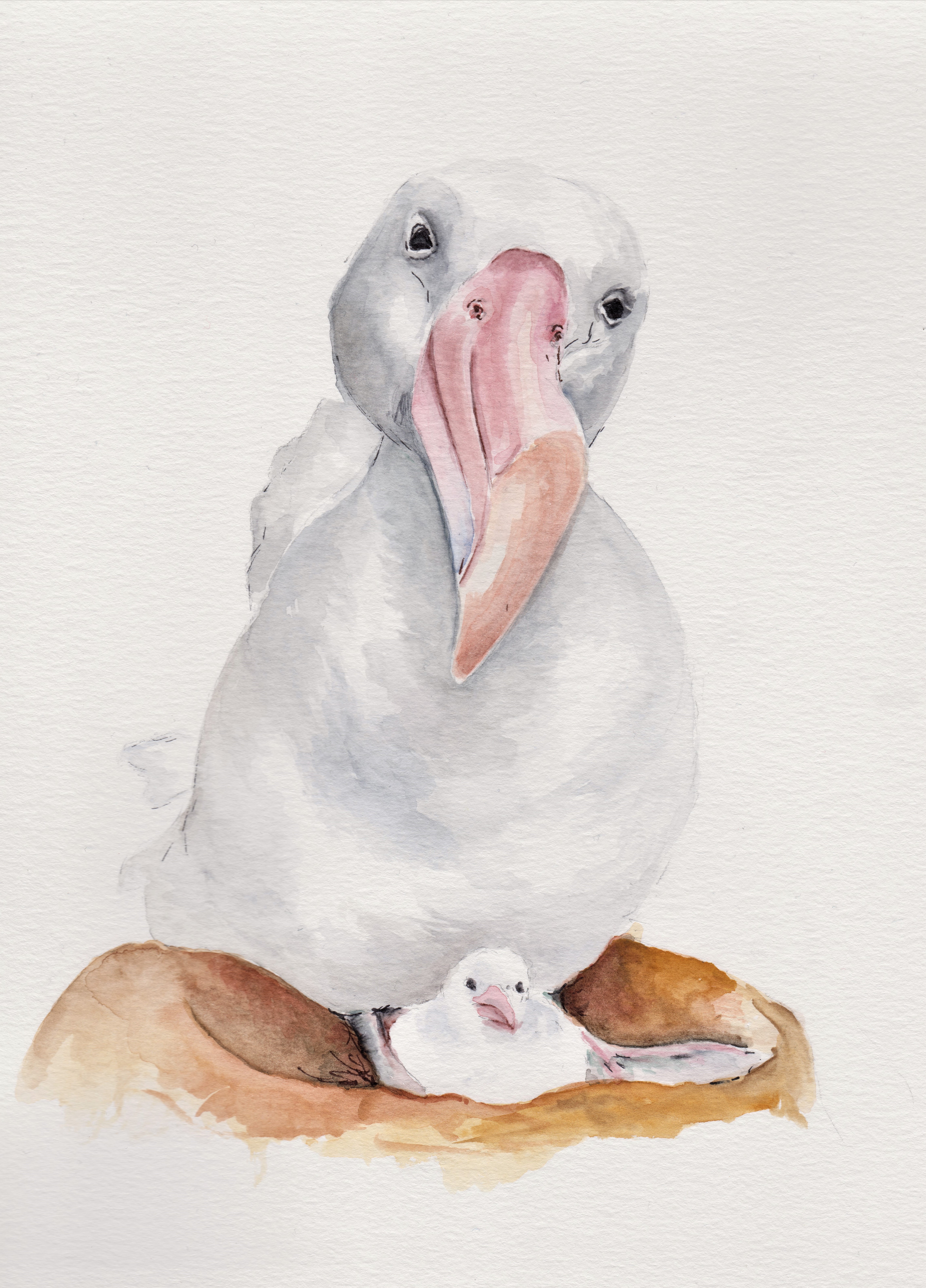 A Wandering Albatross stands over its chick on Marion Island, artwork by Lea Finke of Artists & Biologists Unite for Nature (ABUN) for World Albatross Day 2020, after a photograph by Michelle Risi
A Wandering Albatross stands over its chick on Marion Island, artwork by Lea Finke of Artists & Biologists Unite for Nature (ABUN) for World Albatross Day 2020, after a photograph by Michelle Risi
The Regional Red Data Book of Birds of South Africa, Lesotho and Eswatini 2025 released last month by BirdLife South Africa "presents the most comprehensive and up-to-date regional assessments of bird species across southern Africa".
"Developed through rigorous scientific research and in collaboration with local and international experts, the Red Data Book provides critical insights into the conservation status of birds in the region. It follows the International Union for Conservation of Nature (IUCN) Red List framework, adapted to reflect the unique environmental challenges and species diversity of southern Africa, offering an evidence-based guide to the risks of extinction faced by avian species in the region." [edited]
Bird species that occur regularly within the region considered (which includes surrounding waters and South Africa 's Prince Edward Islands in the southern Indian Ocean) are assessed with a threatened (Critically Endangered (CE), Endangered (E), Vulnerable (V) or Near Threatened (NT) status. Ten threatened/near threatened procellariiform species have been recorded breeding within the region covered, Nine of these are ACAP-listed albatrosses and petrels that breed regulalrly at the Prince Edward Islands, as listed here.
Wandering Albatross Diomedea exulans V
Grey-Headed Albatross Thalassarche chrysostoma E
Indian Yellow-nosed Albatross T. carteri E
Sooty Albatross Phoebetria fusca E
Light-mantled Albatross P, palpebrata V
Northern Giant Petrel Maconectes halli NT
Southern Giant Petrel M, giganteus NT
Grey Petrel Procellaria cinerea E
White-chinned Petrel P. aequinocialis V
Five of the nine ACAP-listed species have been assessed with the same level of threat as they have internationally. The exceptions are Light-mantled Albatross (regionally V, globally NT), Grey Petrel (regionally E, globally NT), Northern Giant Petrel (regionally NT, globally Least Concern) and Southern Giant Petrel (regionally NT, globally Least Concern). These higher levels of threat for four species reflects mainly their small populations at the Prince Edward Islands in relation to their global populations. However, in addition the winter-breeding Grey Petrel is at particular risk from the introduced House Mice on Marion Island (but not on nearby Prince Edward Island where mice do not occur).
Foe each species covred in the new regional RDB detailed information is given under the broad heads, NAMES, CURRENT ASSESSMENT STATUS, HISTORIC LISTING INFORMATION, REASON FOR INCLUSION, CATEGORY JUSTIFICATION, BIOLOGY & ECOLOGY, THREATS & CONSERVATION and CONTRIBUTORS & REFERENCES. For each species a full citation is conveniently given, as in this example written by Kim Stevens (who has studied the species on Marion Island towards her PhD)..
Stevens, K.L. 2025. Grey-headed Albatross. In: Lee, A.T.K., Rose, S., Banda, S., Bezeng, S.B., Maphalala, M.I., Maphisa, D.H. & Smit-Robinson, H. (Eds), The 2025 Red Data Book of Birds of South Africa, Lesotho and Eswatini. BirdLife South Africa: Johannesburg: Available at: https://www.birdlife.org.za/red-list/grey-headed-albatross/.
 "The Albatrosses of the Prince Edward Islands", artwork by Leigh Wolfaardt
"The Albatrosses of the Prince Edward Islands", artwork by Leigh Wolfaardt
I co-authored the very first South African RDB for birds - a very slim volume - way back in 1976. New editions by other authors followed in 1984, 2000 and 2015, all in hard copy, Now online, the fifth edition by Alan Lee, BirdLife South Africa's Science and Innovation Programme Manager, and his team of co-editors, reprents a huge advance in the scholarly interpretation of science and conservation. .
Get online, check it out for free and take the time to browse. Reckon it's quite the tour de force!
John Cooper, Emeritus Information Officer, Agreement on the Conservation of Albatrosses and Petrels, 03 June 2025
I vvco

 English
English  Français
Français  Español
Español